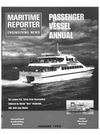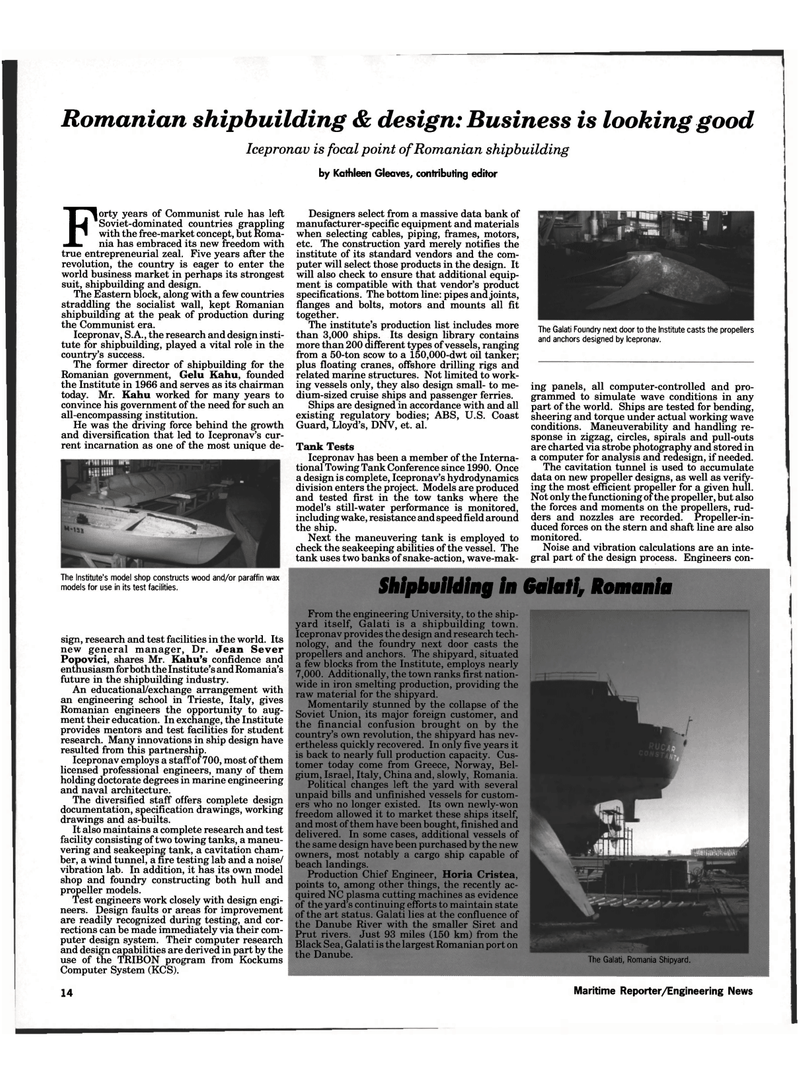
Page 4th Cover: of Maritime Reporter Magazine (January 6, 1995)
Read this page in Pdf, Flash or Html5 edition of January 6, 1995 Maritime Reporter Magazine
Romanian shipbuilding & design: Business is looking good
Icepronav is focal point of Romanian shipbuilding by Kathleen Gleaves, contributing editor
Forty years of Communist rule has left Soviet-dominated countries grappling with the free-market concept, but Roma-nia has embraced its new freedom with true entrepreneurial zeal. Five years after the revolution, the country is eager to enter the world business market in perhaps its strongest suit, shipbuilding and design.
The Eastern block, along with a few countries straddling the socialist wall, kept Romanian shipbuilding at the peak of production during the Communist era.
Icepronav, S.A., the research and design insti- tute for shipbuilding, played a vital role in the country's success.
The former director of shipbuilding for the
Romanian government, Gelu Kahu, founded the Institute in 1966 and serves as its chairman today. Mr. Kahu worked for many years to convince his government of the need for such an all-encompassing institution.
He was the driving force behind the growth and diversification that led to Icepronav's cur- rent incarnation as one of the most unique de-
The Institute's model shop constructs wood and/or paraffin wax models for use in its test facilities. sign, research and test facilities in the world. Its new general manager, Dr. Jean Sever
Popovici, shares Mr. Kahu's confidence and enthusiasm for both the Institute's and Romania's future in the shipbuilding industry.
An educational/exchange arrangement with an engineering school in Trieste, Italy, gives
Romanian engineers the opportunity to aug- ment their education. In exchange, the Institute provides mentors and test facilities for student research. Many innovations in ship design have resulted from this partnership.
Icepronav employs a staff of 700, most of them licensed professional engineers, many of them holding doctorate degrees in marine engineering and naval architecture.
The diversified staff offers complete design documentation, specification drawings, working drawings and as-builts.
It also maintains a complete research and test facility consisting of two towing tanks, a maneu- vering and seakeeping tank, a cavitation cham- ber, a wind tunnel, a fire testing lab and a noise/ vibration lab. In addition, it has its own model shop and foundry constructing both hull and propeller models.
Test engineers work closely with design engi- neers. Design faults or areas for improvement are readily recognized during testing, and cor- rections can be made immediately via their com- puter design system. Their computer research and design capabilities are derived in part by the use of the TRIBON program from Kockums
Computer System (KCS).
Designers select from a massive data bank of manufacturer-specific equipment and materials when selecting cables, piping, frames, motors, etc. The construction yard merely notifies the institute of its standard vendors and the com- puter will select those products in the design. It will also check to ensure that additional equip- ment is compatible with that vendor's product specifications. The bottom line: pipes and joints, flanges and bolts, motors and mounts all fit together.
The institute's production list includes more than 3,000 ships. Its design library contains more than 200 different types of vessels, ranging from a 50-ton scow to a 150,000-dwt oil tanker; plus floating cranes, offshore drilling rigs and related marine structures. Not limited to work- ing vessels only, they also design small- to me- dium-sized cruise ships and passenger ferries.
Ships are designed in accordance with and all existing regulatory bodies; ABS, U.S. Coast
Guard, Lloyd's, DNV, et. al.
Tank Tests
Icepronav has been a member of the Interna- tional Towing Tank Conference since 1990. Once a design is complete, Icepronav's hydrodynamics division enters the project. Models are produced and tested first in the tow tanks where the model's still-water performance is monitored, including wake, resistance and speed field around the ship.
Next the maneuvering tank is employed to check the seakeeping abilities of the vessel. The tank uses two banks of snake-action, wave-mak-
The Galati Foundry next door to the Institute casts the propellers and anchors designed by Icepronav. ing panels, all computer-controlled and pro- grammed to simulate wave conditions in any part of the world. Ships are tested for bending, sheering and torque under actual working wave conditions. Maneuverability and handling re- sponse in zigzag, circles, spirals and pull-outs are charted via strobe photography and stored in a computer for analysis and redesign, if needed.
The cavitation tunnel is used to accumulate data on new propeller designs, as well as verify- ing the most efficient propeller for a given hull.
Not only the functioning of the propeller, but also the forces and moments on the propellers, rud- ders and nozzles are recorded. Propeller-in- duced forces on the stern and shaft line are also monitored.
Noise and vibration calculations are an inte- gral part of the design process. Engineers con-
Shipbuilding in Galati, Romania
From the engineering University, to the ship- yard itself, Galati is a shipbuilding town.
Icepronav provides the design and research tech- nology, and the foundry next door casts the propellers and anchors. The shipyard, situated a few blocks from the Institute, employs nearly 7,000. Additionally, the town ranks first nation- wide in iron smelting production, providing the raw material for the shipyard.
Momentarily stunned by the collapse of the
Soviet Union, its major foreign customer, and the financial confusion brought on by the country's own revolution, the shipyard has nev- ertheless quickly recovered. In only five years it is back to nearly full production capacity. Cus- tomer today come from Greece, Norway, Bel- gium, Israel, Italy, China and, slowly, Romania.
Political changes left the yard with several unpaid bills and unfinished vessels for custom- ers who no longer existed. Its own newly-won freedom allowed it to market these ships itself, and most of them have been bought, finished and delivered. In some cases, additional vessels of the same design have been purchased by the new owners, most notably a cargo ship capable of beach landings.
Production Chief Engineer, Horia Cristea, points to, among other things, the recently ac- quired NC plasma cutting machines as evidence of the yard's continuing efforts to maintain state of the art status. Galati lies at the confluence of the Danube River with the smaller Siret and
Prut rivers. Just 93 miles (150 km) from the
Black Sea, Galati is the largest Romanian port on the Danube. The Galati, Romania Shipyard. 14 Maritime Reporter/Engineering News

 3rd Cover
3rd Cover

